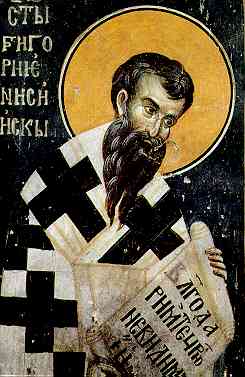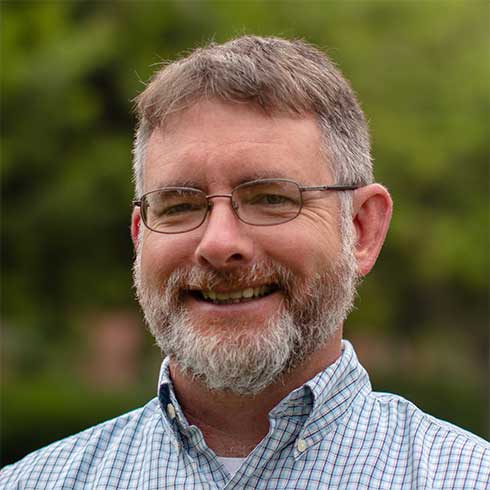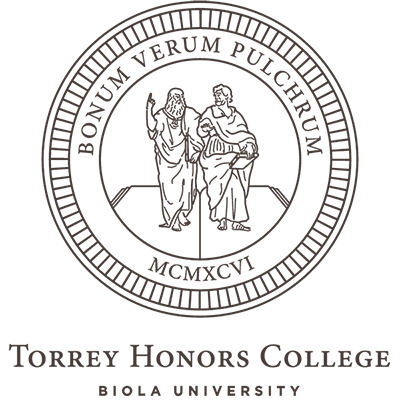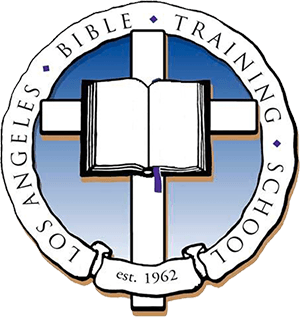A scene from The Canterbury Psalter (12th century)
Blog
“Every Vision, Every Theophany, Every Word” (Nyssa)

Gregory of Nyssa, in his work Refutation of Eunomius’ Confession,1 has a powerful set of arguments for the deity of the Holy Spirit. Most of them involve gathering and linking places in Scripture that affirm the same divine things as applying to the Father, Son, and Spirit.
For example, he notes the word “fullness” as applying both to the incarnate Son (“in him dwelleth the fullness of the Godhead,” Col 2:9) and to the outpoured Spirit: “So also when the Lord by breathing upon His disciples had imparted to them the Holy Spirit, John says, “Of His fulness have all we received.” Notice that this last citation shows that Nyssa reads John 1:16 as written in the time of fulfilment of John 20:21: Since the risen Lord breathed out the Spirit on the apostles, one of them could write that he had received the Spirit as the fullness of Christ. Hermeneutical moves like this are not so much proofs as they are angles of insight into the accomplished reality of revelation.
A fuller, because more triadic, example is the vision of the lofty and enthroned divinity described in Isaiah 6. Nyssa says that this “manifestation of the Divine appearance” is often considered to be the Father. But in John 12:41, the evangelist explains that Isaiah saw the glory of Jesus, and spoke of him. But Nyssa goes even further: “The mighty Paul attributes the same passage to the Holy Spirit in his speech made to the Jews at Rome, when he says, ‘Well spoke the Holy Ghost by Esaias the prophet concerning you, saying, Hearing ye shall hear and shall not understand.'” (Acts 28:25)
In other words, the whole throne-room vision, with its accompanying commissioning speech, is somehow a seeing and hearing of God that we have New Testament warrant for attributing to all three persons of the Trinity. And Nyssa draws the following conclusion:
“In my opinion, this shows by Holy Scripture itself, that every specially divine vision, every theophany, every word uttered in the Person of God, is to be understood to refer to the Father, the Son, and the Holy Spirit.” [πᾶσα ὀπτασία θειοτέρα καὶ πᾶσα θεοφάνεια καὶ πᾶς λόγος ἐκ προσώπου θεοῦ λεγόμενος ἐπὶ τοῦ πατρὸς νοεῖται καὶ ἐπὶ τοῦ υἱοῦ καὶ ἐπὶ τοῦ πνεύματος τοῦ ἁγίου.]
That is quite a conclusion, and it is stated quite expansively.
Now whenever an early Christian theologian carries out Trinitarian reasoning in this manner (gathering texts from around the Bible and connecting them to Father, Son, and Holy Spirit), they are following standard procedure for demonstrating doctrinal affirmations like the inseparability of the Trinity’s external operations, and doing so in the context of saying how characteristic actions are appropriated to particular persons non-exclusively. In this case, Nyssa seems to be working in this witness-gathering territory with a special eye to refuting Eunomian attempts at subordinationism. By showing that the one on the throne is to be looked upon also as the Son, and listened to also as the Spirit, he is tying together trinitarian being and action very tightly indeed. The three persons are one God, and act as one God. His key point, in context, is that this divine action can be referred to the Father, the Son, and the Spirit, excluding none of them.
Though it is not the thrust of his argument, Nyssa summarizes his results in a way that also seems to have implications for the question of interpreting the theophanies in the Old Testament using trinitarian categories. His principle seems to be that important passages like Isaiah 6 are rightly understood as manifestations that refer to Father, Son, and Holy Spirit. The vision of Isaiah is in fact one instance of a broader principle. We should understand all such manifestations (“every specially divine vision, every theophany, every word uttered in the Person of God”) as in fact fully Trinitarian (“understood to refer to the Father, the Son, and the Holy Spirit”).
[A quick aside: the phrase “uttered in the Person of God” (ἐκ προσώπου θεοῦ λεγόμενος) might alarm you if you take “person” to be functioning in the technical trinitarian sense. That misreading would entail that Nyssa thinks there is such a thing as a single, unified divine person capable of speaking as the person who is God but who is not one of the three. Who? But no: “in the person of God” here is an idiom from rhetorical analysis, meaning no more than that God speaks. The 19th-century translator’s capitalizing of Person makes it even more misleading.]
Theodore de Regnon called this sentence of Nyssa’s “a very Augustinian explanation of the theophanies!” (Etudes, volume 3, p. 137) What did he mean by that? Well, imagine that you have in your mind some rough distinctions between Eastern and Western forms of trinitarian theology (as De Regnon famously did). Imagine that the East tends to emphasize distinction of the persons, while the West tends to emphasize unity of substance. And then posit that even within the Western tradition, Augustine is especially committed to the notion that the persons of the Trinity are never behaving as isolated agents doing solo projects; that is, he argues that the external works of the Trinity are are undivided. Well, working within that schema, you’re going to hit sentences like this in Nyssa and remark, “how very Augustinian.”
It is true that this line of argument in Nyssa seems to align pretty nicely with the argument of Augustine’s De Trinitate (Book 2). But I suspect that in his treatment of the theophanies, Augustine is not really all that much of an outlier, either to the Western tradition or to the entire early Christian pattern of interpretation. In my own reading of Augustine, I see him as being more explicit than anybody else about the actual modes of causation involved in theophanies: who made that fire, that dove, that earthquake, that visual phenomenon seen by human eyes? When you put the question that way, and you’re working from a concrete, trinitarian form of monotheism, you’re bound to say some of the things Augustine said.
As far as I can see, Nyssa never raises quite the same questions as Augustine on the causation behind the theophanies (I confess there are long stretches of Nyssa’s work that I haven’t read, and he seems capable of saying almost anything at any time). But there are hints here and there in Nyssa that, had he raised these questions, he would have answered them in a way pretty similar to Augustine.
___________________________________
1To read Nyssa’s excellent Refutation of Eunomius’ Confession, the trick is to get the “Nyssa’s Dogmatic Works” volume of Schaff’s Nicene and Post-Nicene Fathers, series 2, volume 5, and turn to the section presented there under the name of Contra Eunomium Book 2 (see here). The text there is not in fact Contra Eunomium Book 2! It’s this other work from after 382, the Refutation. There were textual transmission issues that got sorted out after publication of the Schaff volumes (which I think were perpetuating Migne errors). The critical Greek text of the Refutation of Eunomius’ Confession is in Gregorii Nysseni Opera volume 2. The Schaff edition is of course extremely widely available in print and online, and it’s impossible to slap a warning sticker on it to let everybody know about the underlying disorder. Alas! Thanks to Andrew Radde-Gallwitz and Mark DelCogliano for explaining this to me on Twitter. Radde-Gallwitz’s book on Nyssa’s dogmatic writings is here.
So the good news is, there’s a Nyssa book you didn’t know you wanted to read, hiding for all these years inside of the Schaff Contra Eunomium and disguised as its book 2! Furthermore, if you’ve got that volume, you’re also carrying around Nyssa’s actual book 2 of Contra Eunomium, along with book 3. The bad news is, to read CE, you’ll have to do a secret trick, explained here in a chart shared by DelCogliano:
CE 1: NPNF 2.5, 35-100
CE 2: NPNF 2.5, 250-314
CE 3: NPNF 2.5, 135-248
Refutation: NPNF 2.5, 101-134
There’s more bad news, involving (shudder) long recensions and such. But it’s a lot of Nyssa on the Trinity, and at some point in Contra Eunomium ordinary people, even Nyssa fans, start noticing it’s prolix, repetitive, and more detailed than is necessary for most people not actively engaged in combating Eunomianism.
About This Blog

Fred Sanders is a theologian who tried to specialize in the doctrine of the Trinity, but found that everything in Christian life and thought is connected to the triune God.


